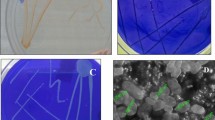Abstract
Studies carried out onClostridium saccharoperbutylacetonicum (ATCC 27022) reveal that intracellular and extracellular inhibitors, including metabolic end-products, caused the inhibition of cell growth and solvent production. Butanol at the level of 13.0 g/liter was completely inhibitory to the growth of cells, whereas butyric acid totally inhibited the cell growth at a concentration of 8.7 g/liter. Investigations carried out on the effect of addition of culture filtrate concentrate and cell-free extract concentrate indicate that nonvolatile inhibitors produced by cells were also inhibitory for bioconversion. The butanol production was found to be reduced by 15%–20% on addition of cell-free extract concentrate. Inhibition by concentrates was enhanced in the presence of butanol. Addition of heat-sterilized concentrates resulted in a reduction of inhibition.
Similar content being viewed by others
Literature Cited
Bahl H, Gothwald M, Kuhn A, Rafe V, Andersch W, Gottschalk G (1986) Nutritional factors affecting the ratio of solvents produced byClostridium acetobutylicum. Appl Environ Microbiol 52:169–172
Boulanger Y, Schreiev S, Smith ICP (1976) Molecular details of anesthetic lipid interaction as seen by deuterium and phosphorous-31 nuclear magnetic resonance. Biochemistry 20:6824–6830
Bowles LK, Ellefson WL (1985) Effects of butanol onClostridium acetolbutylicum. Appl Environ Microbiol 50:1165–1170
Browing JL, Akutsu H (1982) Local anesthetic and divalent cations have the same effect on the head groups of phosphatidylcholine and phosphatidylethanol amine. Biochim Biophys Acta 684:172–178
Calam CT (1980) Isolation ofClostridium acetobutylicum strains producing butanol and acetone. Biotech Lett 2:111–116
Datta R, Zeikus JG (1985) Modulation of acetone-butanol-ethanol fermentation by carbon monoxide and organic acids. Appl Environ Microbiol 49:522–529
Gottwald M, Gottschalk G (1985) The internal pH ofClostridium acetobutylicum and its effect on the shift from acid to solvent formation. Arch Microbiol 143:42–46
Huang L, Forsberg CW, Gibbins LNC (1986) Influence of external pH and fermentation products onClostridium acetobutylicum intracellular pH and cellular distribution of fermentation products. Appl Environ Microbiol 51:1230–1234
Huang L, Gibbins LN, Forsberg CW (1985) Transmembrane pH gradient and membrane potential inClostridium acetobutylicum during growth under acetogenic and solventogenic conditions. Appl Environ Microbiol 30:1043–1047
Ingram LO (1976) Adaptation of membrane lipids to alcohol. J Bacteriol 125:670–678
Kim BN, Bellows P, Datta R, Zeikus JG (1984) Control of carbon and electron flow inClostridium acetobutylicum fermentation: utilization of carbon monoxide to inhibit hydrogen production and to enhance butanol yields. Appl Environ Microbiol 48:764–770
Lenaz G, Parenti CG, Sechi AM (1975) Lipid-protein inter-actions in mitochondria: changes in mitochondrial adenosine triphosphatase activity induced by n-butyl alcohol. Arch Biochem Biophys 167:72–79
Lenz TG, Moreira AR (1980) Economic evaluation of acetone-butanol fermentation. Ind Eng Chem Prod Res Dev 19:478–483
Leung JCY, Wang DIC (1981) Production of acetone and butanol byClostridium acetobutylicum in continuous culture using free cells and immobilized cells. Proc 2nd World Congr Chem Eng 1:348–352
Moreira AR, Ulmer DC, Linden JC (1981) Butanol toxicity in the butyric fermentation. Biotech Bioeng Symp 11:567–579
Ogata S, Hongo M (1974) Lysis induced by sodium ion and its correlation to lytic enzyme systems inClostridium saccharoperbutylacetonicum. J Gen Microbiol 81:315–323
Paterson SJ, Butler KW, Huang P, Belle JL, Smith ICP, Schneider H (1972) The effect of alcohol on lipid bilayers: a spin label study. Biochim Biophys Acta 266:597–602
Schoutens GH, Groot WH (1985) Economic feasibility of the production of isopropanol-butanol-ethanol fuels from whey permeate. Proc Biochem 20:117–121
Soni BK, Das K, Soucaille P, Goma G (1986) Batch and continuous studies for improved productivity byClostridium saccharoperbutylacetonicum for acetone-butanol fermentation. Biotech Bioeng Symp No 17:591–603
Soni BK, Soucaille P, Goma G (1986) Effect of phosphate cycling on production of acetone-butanol byClostridium acetobutylicum in chemostat culture. Biotech Bioeng Symp No 17:239–252
Soucaille P, Goma G (1986) Acetonobutylic fermentation byClostridium acetobutylicum ATCC 824: Autobacteriocin production, properties and effects. Current Microbiol 13:163–169
Terraciano JS, Kashket ER (1986) Intracellular conditions required for initiation of solvent production byClostridium acetobutylicum. Appl Environ Microbiol 52:86–91
Yoshino S, Ogata S, Hayashida S (1982) Some properties of autolysin ofClostridium saccharoperbutylactonicum. Agric Biochem 46:1243–1248
Author information
Authors and Affiliations
Rights and permissions
About this article
Cite this article
Soni, B.K., Das, K. & Ghose, T.K. Inhibitory factors involved in acetone-butanol fermentation byClostridium saccharoperbutylacetonicum . Current Microbiology 16, 61–67 (1987). https://doi.org/10.1007/BF01588173
Issue Date:
DOI: https://doi.org/10.1007/BF01588173




